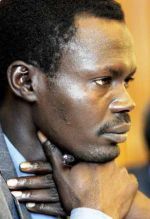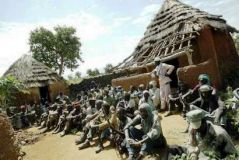Rebel groups in Sudan’s Darfur
KHARTOUM, Dec 18 (AFP) — The two groups that have led the rebellion in Darfur have different goals but have so far remained united against the Sudanese government, as well as against a third movement that signed a peace deal with Khartoum.

|
|
SLA secretary general Minni Arkou Minnawi. |
The largest of the two organisations is the Sudan Liberation Army/Movement (SLA/M), whose devastating attacks against government positions in the western Darfur region marked the beginning of the rebellion in February 2003.
The next month, SLA secretary general Minni Arkou Minnawi issued a “political declaration” stating that the movement’s goal was to oust the Islamic regime in Khartoum and put an end to the “marginalisation” of Darfur.
The origins of the SLA can be traced back to the late 1980s, when black African tribes joined forces to oppose a government-backed Arab alliance harassing farming communities in the region.

|
|
Sudan Liberation Army rebels from different bases come together for a meeting in Tarenjer village, west Darfur, October 11, 2004. |
Under the leadership of Abdel Wahed Mohammed al-Nur, the grouping of militias became the Darfur Liberation Front in 2001, before further expanding and eventually changing its name to the SLA in March 2003.
It was the SLA’s raids on police stations and other government positions from its mountain redoubts that prompted the government to unleash its infamous “Janjaweed” — Arab proxy militias which have since been accused of genocide.
Outnumbered but not outwitted by pro-government forces, the SLA has played a chiefly military role in the rebellion and has been suspected of receiving support from Eritrea.
Fighting mainly for its land and against government oppression, it is thought to be ideologically close to John Garang’s Sudan People’s Liberation Army, which has led the 21-year-old rebellion in the south.
The Justice and Equality Movement (JEM), the other major Darfur rebel group, has very different roots and objectives. It is close to Islamist Hassan al-Turabi, one-time mentor of President Omar al-Beshir who is now his main opponent.
When Turabi tried to curb Beshir’s power in 1999, the president reacted by expelling him and his Islamist supporters from government.
The disgraced Turabi loyalists of Muslim African origin went on to constitute the core of the JEM’s current leadership, although the group denies any direct links with Turabi.
More than a liberation movement, the JEM is seen as an organisation used as a tool by members of the political opposition to destabilise Beshir’s regime.
Although the vastly diverging agendas of the two groups have complicated ongoing peace negotiations with the government in Abuja, few cracks have so far appeared in the unlikely SLA-JEM alliance.
Both of them have also dismissed a third group, which appeared very late in the game, the National Movement for Reform and Development (NMRD).
Although it presents itself as a dissident wing of the JEM, both main rebel groups have denied any links with NMRD and accuse it of being a government fabrication.
When the alleged splinter faction appeared on the scene a few months ago, government-run media outlets gave abundant publicity to what was described as divisions in rebel ranks.
The announcement that the NMRD had signed an eight-point peace deal with Khartoum in Chad on Friday sparked the fury of the two other groups.
Mohammed Ahmed Tugod, chief JEM negotiator at the Abuja talks, charged the NMRD was “a new Janjaweed started by the Sudanese government”.
He said the JEM and SLA/M would refuse the NMRD’s presence at any future negotiations.
